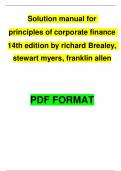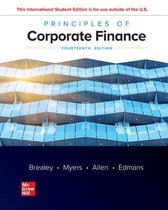Solution manual for
principles of corporate finance
14th edition by richard Brealey,
stewart myers, franklin allen
PDF FORMAT
, CHAPTER 1
Introduction to Corporate Finance
The values shown in the solutions may be rounded for display purposes. However, the answers were
derived using a spreadsheet without any intermediate rounding.
Answers to Problem Sets
1. a. real
b. executive airplanes
c. brand names
d. financial
e. bonds
*f. investment or capital expenditure
*g. capital budgeting or investment
h. financing
*Note that f and g are interchangeable in the question.
Est time: 01-05
2. A trademark, a factory, undeveloped land, and your work force (c, d, e, and g) are all real assets.
Real assets are identifiable as items with intrinsic value. The others in the list are financial assets,
that is, these assets derive value because of a contractual claim.
Est time: 01-05
3. a. Financial assets, such as stocks or bank loans, are claims held by investors.
Corporations sell financial assets to raise the cash to invest in real assets such as plant
and equipment. Some real assets are intangible.
b. Capital expenditure means investment in real assets. Financing means raising the cash
for this investment.
c. The shares of public corporations are traded on stock exchanges and can be purchased
by a wide range of investors. The shares of closely held corporations are not publicly
traded and are held by a small group of private investors.
d. Unlimited liability: Investors are responsible for all the firm‘s debts. A sole proprietor has
unlimited liability. Investors in corporations have limited liability. They can lose their
investment, but no more.
Est time: 01-05
,4. Items c and d apply to corporations. Because corporations have perpetual life, ownership can be
transferred without affecting operations, and managers can be fired with no effect on ownership.
Other forms of business may have unlimited liability and limited life.
Est time: 01-05
5. Separation of ownership facilitates the key attributes of a corporation, including limited liability for
investors, transferability of ownership, a separate legal personality of the corporation, and
delegated centralized management. These four attributes provide substantial benefit for
investors, including the ability to diversify their investment among many uncorrelated returns—a
very valuable tool explored in later chapters. Also, these attributes allow investors to quickly exit,
enter, or short sell an investment, thereby generating an active liquid market for corporations.
However, these positive aspects also introduce substantial negative externalities as well. The
separation of ownership from management typically leads to agency problems, where managers
prefer to consume private perks or make other decisions for their private benefit—rather than
maximize shareholder wealth. Shareholders tend to exercise less oversight of each individual
investment as their diversification increases. Finally, the corporation‘s separate legal personality
makes it difficult to enforce accountability if they externalize costs onto society.
Est time: 01-05
6. Shareholders will only vote to maximize shareholder wealth. Shareholders can modify their
pattern of consumption through borrowing and lending, match risk preferences, and hopefully
balance their own checkbooks (or hire a qualified professional to help them with these tasks).
Est time: 01-05
7. If the investment increases the firm‘s wealth, it increases the firm‘s share value. Ms. Espinoza
could then sell some or all these more valuable shares to provide for her retirement income.
Est time: 01-05
8. a. Assuming that the encabulator market is risky, an 8% expected return on
the F&H encabulator investments may be inferior to a 4% return on U.S.
government securities, depending on the relative risk between the two assets.
b. Unless the financial assets are as safe as U.S. government securities, their cost of capital
would be higher. The CFO could consider expected returns on assets with similar risk.
Est time: 06-10
9. Managers would act in shareholders‘ interests because they have a legal duty to act in their
interests. Managers may also receive compensation— bonuses, stock, and option payouts with
value tied (roughly) to firm performance. Managers may fear personal reputational damage from
not acting in shareholders‘ interests. And managers can be fired by the board of directors (elected
by shareholders). If managers still fail to act in shareholders‘ interests, shareholders may sell
their shares, lowering the stock price and potentially creating the possibility of a takeover, which
can again lead to changes in the board of directors and senior management.
Est time: 01-05
, 10. Managers that are insulated from takeovers may be more prone to agency problems and
therefore more likely to act in their own interests rather than in shareholders‘. If a firm instituted a
new takeover defense, we might expect to see the value of its shares decline as agency
problems increase and less shareholder value maximization occurs. The counterargument is that
defensive measures allow managers to negotiate for a higher purchase price in the face of a
takeover bid—to the benefit of shareholder value.
Est time: 01-05
Appendix Questions:
1.Both would still invest in their friend‘s business. A invests and receives $121,000 for his
investment at the end of the year—which is greater than the $120,000 that would be received
from lending at 20% ($100,000 × 1.20 = $120,000). G also invests, but borrows against the
$121,000 payment, and thus receives $100,833 ($121,.20) today.
Est time: 01-05
2. a. He could consume up to $200,000 now (forgoing all future consumption) or up to $216,000
next year ($200,000 × 1.08, forgoing all consumption this year). He should invest all of his wealth
to earn $216,000 next year. To choose the same consumption (C) in both years, C = ($200,000
– C) × 1.08 = $103,846.
Dollars Next Year
220,000
216,000
203,704
200,000
Dollars Now
b. He should invest all of his wealth to earn $220,000 ($200,000 × 1.10) next year. If he
consumes all this year, he can now have a total of $203,703.70 ($200,000 × 1.10/1.08) this year
or $220,000 next year. If he consumes C this year, the amount available for next year‘s
consumption is ($203,703.70 – C) × 1.08. To get equal consumption in both years, set the
amount consumed today equal to the amount next year:
C = ($203,703.70 – C) × 1.08
C = $105,769.20
Est time: 06-10





